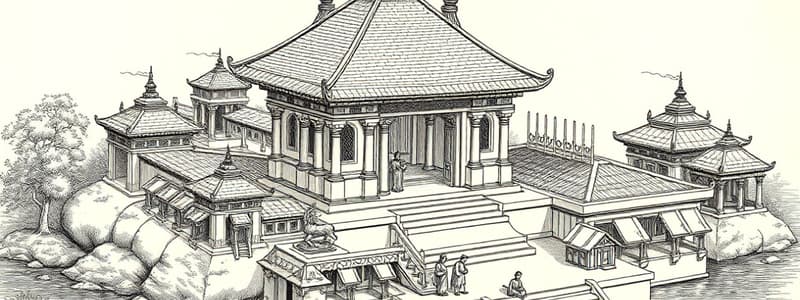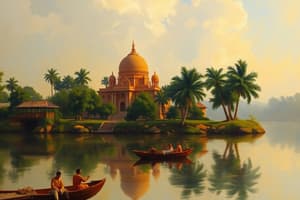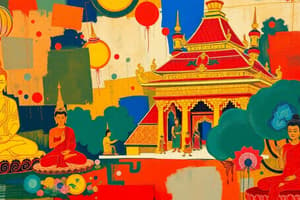Podcast
Questions and Answers
What is the earliest known source of information about the Pala Dynasty?
What is the earliest known source of information about the Pala Dynasty?
Arab traveler Sulaiman's writings.
What were some of the key sources of information used to learn about the Pala Dynasty besides Sulaiman's account?
What were some of the key sources of information used to learn about the Pala Dynasty besides Sulaiman's account?
Copper plate inscriptions, Tibetan chronicles, and Pala rulers with extensive cultural and political ties to Tibet.
What was the estimated size of the Pala rulers' army?
What was the estimated size of the Pala rulers' army?
Between 10,000 and 15,000 infantry, and a cavalry force of about 50,000 personnel.
What is the significance of the copper plate inscriptions in understanding the Pala Dynasty?
What is the significance of the copper plate inscriptions in understanding the Pala Dynasty?
What evidence indicates that the Pala Dynasty had strong relations with Tibet?
What evidence indicates that the Pala Dynasty had strong relations with Tibet?
Besides Sulaiman, who else offered valuable insights into the Pala Dynasty?
Besides Sulaiman, who else offered valuable insights into the Pala Dynasty?
How long, according to the information given, did the Pala Dynasty last?
How long, according to the information given, did the Pala Dynasty last?
Identify notable Pala monarchs based on the information given, in chronological order.
Identify notable Pala monarchs based on the information given, in chronological order.
Who was the Pala king during Sulaiman's visit?
Who was the Pala king during Sulaiman's visit?
What were the three main dynasties mentioned in the provided text?
What were the three main dynasties mentioned in the provided text?
Who is the Arab traveler mentioned in the text, and when did he travel?
Who is the Arab traveler mentioned in the text, and when did he travel?
Which dynasty was engaged in wars with both the Rashtrakutas and the Pratiharas?
Which dynasty was engaged in wars with both the Rashtrakutas and the Pratiharas?
List at least three sources of information used to learn about the Pala Dynasty.
List at least three sources of information used to learn about the Pala Dynasty.
What is indicated by the text about the cultural and political interaction between the Pala dynasty and Tibet?
What is indicated by the text about the cultural and political interaction between the Pala dynasty and Tibet?
What role did Buddhism play in the cultural and religious life of both the Pala dynasty and Tibet?
What role did Buddhism play in the cultural and religious life of both the Pala dynasty and Tibet?
What is the approximate time span of the Pala Dynasty, as indicated by the text?
What is the approximate time span of the Pala Dynasty, as indicated by the text?
How did the Pala rulers influence cultural and political interactions with Tibet?
How did the Pala rulers influence cultural and political interactions with Tibet?
Considering the information provided, what is the importance of using multiple sources to study the Pala Dynasty?
Considering the information provided, what is the importance of using multiple sources to study the Pala Dynasty?
What significant influence did the Pala rulers have in relation to Buddhism?
What significant influence did the Pala rulers have in relation to Buddhism?
Who are Dipankara and Santa-Rakshita commonly referred to as?
Who are Dipankara and Santa-Rakshita commonly referred to as?
What new form of Buddhism was introduced in Tibet by Pala scholars?
What new form of Buddhism was introduced in Tibet by Pala scholars?
What was the role of Nalanda University in the context of Buddhism?
What was the role of Nalanda University in the context of Buddhism?
What was the cultural impact of Buddhism in Tibet during the Pala Dynasty?
What was the cultural impact of Buddhism in Tibet during the Pala Dynasty?
How did the Pala Dynasty contribute to the development of Tantric Buddhism?
How did the Pala Dynasty contribute to the development of Tantric Buddhism?
What two universities are mentioned as centers of Buddhist learning during the Pala period?
What two universities are mentioned as centers of Buddhist learning during the Pala period?
What combination comprises Tantric Buddhism?
What combination comprises Tantric Buddhism?
Describe the relationship between Tibet and Buddhism based on the Pala rulers' influence.
Describe the relationship between Tibet and Buddhism based on the Pala rulers' influence.
Flashcards
Who was Sulaiman?
Who was Sulaiman?
A wealthy Arab traveler who visited India in the 9th century.
What are the sources of information about the Pala Dynasty?
What are the sources of information about the Pala Dynasty?
They provided insights about the Pala Empire during the 9th century.
What were written accounts of the Pala Dynasty?
What were written accounts of the Pala Dynasty?
They were written accounts that describe the political and cultural aspects of the Pala Dynasty.
What were copper plate inscriptions?
What were copper plate inscriptions?
Signup and view all the flashcards
What role did Tibetan chronicles play in understanding the Pala Dynasty?
What role did Tibetan chronicles play in understanding the Pala Dynasty?
Signup and view all the flashcards
How big was the army of the Pala King?
How big was the army of the Pala King?
Signup and view all the flashcards
Who were the Pala Kings?
Who were the Pala Kings?
Signup and view all the flashcards
What was the Pala Dynasty's reign like?
What was the Pala Dynasty's reign like?
Signup and view all the flashcards
Who were the successors of the Pala Kings?
Who were the successors of the Pala Kings?
Signup and view all the flashcards
Who was Dharma Pala, and why is he important?
Who was Dharma Pala, and why is he important?
Signup and view all the flashcards
Pala Dynasty
Pala Dynasty
Signup and view all the flashcards
Cultural Exchange of Pala Dynasty
Cultural Exchange of Pala Dynasty
Signup and view all the flashcards
Influential Buddhism under Pala
Influential Buddhism under Pala
Signup and view all the flashcards
Vajrayana Buddhism
Vajrayana Buddhism
Signup and view all the flashcards
Vajrayana Buddhism - Definition
Vajrayana Buddhism - Definition
Signup and view all the flashcards
Buddhist Universities under Pala
Buddhist Universities under Pala
Signup and view all the flashcards
Nalanda and Vikramasila - Importance
Nalanda and Vikramasila - Importance
Signup and view all the flashcards
Pala's Role in Tibetan Buddhism
Pala's Role in Tibetan Buddhism
Signup and view all the flashcards
Tibetan Buddhist Learning
Tibetan Buddhist Learning
Signup and view all the flashcards
Notable Buddhist Scholars
Notable Buddhist Scholars
Signup and view all the flashcards
Sulaiman
Sulaiman
Signup and view all the flashcards
Sources of History
Sources of History
Signup and view all the flashcards
Pala Dynasty and Its Neighbors
Pala Dynasty and Its Neighbors
Signup and view all the flashcards
Pala Dynasty and Tibet
Pala Dynasty and Tibet
Signup and view all the flashcards
Pala Dynasty's Cultural and Political Influence
Pala Dynasty's Cultural and Political Influence
Signup and view all the flashcards
Buddhism's Influence
Buddhism's Influence
Signup and view all the flashcards
Copper Plates and Inscriptions
Copper Plates and Inscriptions
Signup and view all the flashcards
Pala Rulers
Pala Rulers
Signup and view all the flashcards
Pala Dynasty's Time Span
Pala Dynasty's Time Span
Signup and view all the flashcards
Study Notes
Pala Dynasty - Sources of History
- The Pala Dynasty existed from approximately 750 AD to 1162 AD.
- Key rulers included Gopala, Dharmapala, and Devapala.
- Later rulers included Mahipala.
- Sources of information about the Pala Dynasty include Arab travellers, like Sulaiman, and Tibetan Chronicles.
- Written accounts from Arab travelers offer insights.
- Copper plate inscriptions are also a source.
- The Palas had significant cultural and political connections with Tibet.
- The Palas maintained extensive cultural and political ties with Tibet.
- The Pala army was a significant force, estimated to be 10,000 - 15,000 soldiers, with a total strength of around 50,000.
- The Palas were often at war with neighboring kingdoms.
- The Rashtrakutas, Prathiharas, and other kingdoms were among the Pala's rivals.
- Buddhism was a major cultural and religious influence in both the Pala kingdom and Tibet.
- Buddhist scholars, including Dipankara (also known as Atiśa) and Śāntarakṣita, played important roles in spreading Buddhism.
- Tantric Buddhism developed in Tibet as part of the Pala interaction.
- Notable Buddhist universities like Nalanda and Vikramasila flourished under Pala patronage, which contributed to the spread of knowledge and also religious influence.
Studying That Suits You
Use AI to generate personalized quizzes and flashcards to suit your learning preferences.




